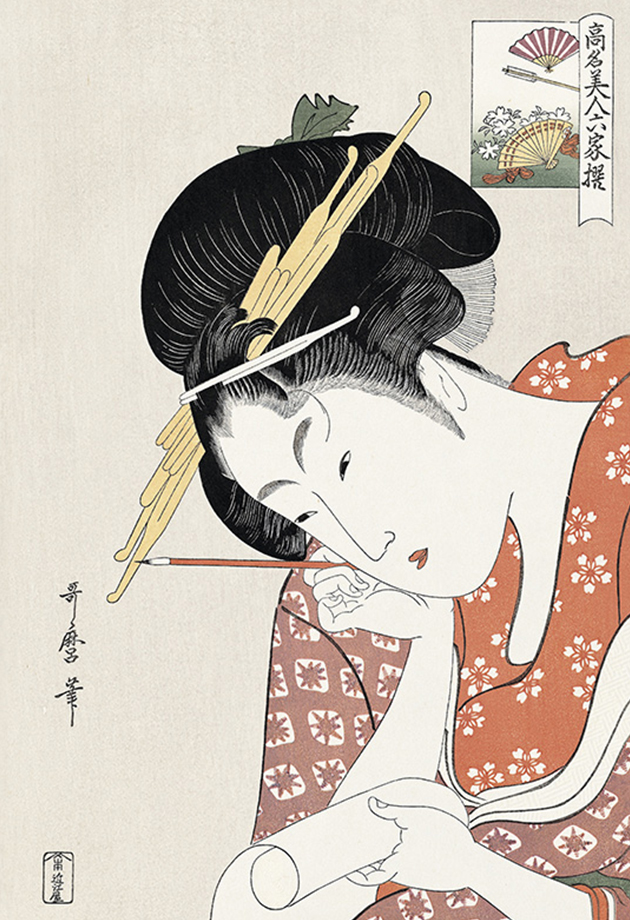
Anno Moyoco "Sakuran",
ukiyo-e style woodcut print in "Echizen Kizuki Hosho Washi"
made by living national treasure Mr.Ichibei Iwano,
2016 © Moyoco Anno / Cork, Courtesy of AI KOWADA GALLERY
Back in the eighteenth century, Kitagawa Utamaro, the legendary ukiyoe artist vividly depicted the idealized images of the beautiful courtesans who in reality were suffering a tough life in Yoshihara: Edo’s expensive and high-class red light district authorized by the Tokugawa shogunate. The artist served the mass’s fantasy for Yoshihara and its inhabitants with his inexpensive small format prints that were available for the common people of that time at very cheap prices which functioned like movie stars’ publicity shots of today.
On the other hand, Anno Moyoco, the charismatic contemporary Japanese manga artist, has chosen as her protagonists, the prostitutes from different eras and parts of the world in her two blockbuster manga series: “Sakuran” and “Memoirs of Amorous Gentlemen”.
This exhibition presents Anno’s woodblock print portraits of her heroines from the aforementioned two mangas created in the method of authentic ukiyoe production using printing blocks made of cherry tree wood. The production was done with the help of an artisan who specialises in making accurate reproductions of the works by famous ukiyoe artists such as Hokusai, Utamaro, Hiroshige and Sharaku, as well as serving as a master printer for the contemporary painters of international recognition like Kusama Yayoi. The original prints by Anno will be shown alongside the Utamaro prints skilfully reproduced by the master printer. Thus, with about ten works made by the top creators of the mass art from the two separate eras, the show aims to provide a unique chance for the viewers to contemplate the ideals of the feminine beauty in Japanese popular culture from the past and the present.
Recently, Anno’s art was recognised as having artistic value by Mika Ninagawa,the well-known contemporary artist-photographer by making“Sakuran”into an film in 2007,the key for such acclaim seems to be Anno’s unique treatment of the subject of prostitution that relates the situation of the girls in the business to that of other young women striving to survive in the contemporary society, whom Anno has so well portrayed in many of her other stories.
In 2014, the Honolulu Museum of Art which holds the third largest collection of ukiyoe in the US added Anno’s work into their collection on the occasion of their exhibition titled “Modern Love: 20th-Century Japanese Erotic Art”, where they presented Anno’s art as the modern day shunga along with the arts by other artists such as the photographs by Nobuyoshi ARAKI.
"To be honest, I know that getting a boyfriend is not really a guarantee for a happy life." ~ Happy Mania
"I wanna be able to think while lying on my death bed, that I had really devoted myself to my professional life."~Hataraki Man
"If I get thin, I would grasp a happiness that shines so much more than the life I have now." ~ In Clothes Called Fat
The above quotes of Anno’s heroines reveal how they chase after the illusion of happiness that does not really exist while trapped in the system of the contemporary world just like Utamaro’s courtesans who yearned for the freedom outside the strict agreement made between their relatives and the brothel.
By looking at the images of the unrealistically elegant courtesans on two dimensional formats, we may ask for ourselves, how much freedom have women gained in the past two hundred years both inside and outside Japan? Can humans ever be free from the society they belong to?
--
ANNO Moyoco
A Japanese manga artist born in 1971 in Tokyo.She won Kodansha’s 29th manga Awar
d. Her mega
hit serialized manga work “Happy Mania” from 1995 which was made into a TV drama broadcasted on Fuji Television Network. Another of her serialized work“The Workaholic”from 2006 was made into an animation drama shown on the same network. The work was also made into a TV drama series broadcasted via Nippon Television Network. In 2007, Mika NINAGAWA made the live action film of “Sakuran”.
Public collection ; Honolulu Museum of Art.

Hanaogi of the Ogiya, from the series
"Renowned Beauties Likened to the Six Immortal Poets (Komei bijin rokkasen)",
c. 1795/2016